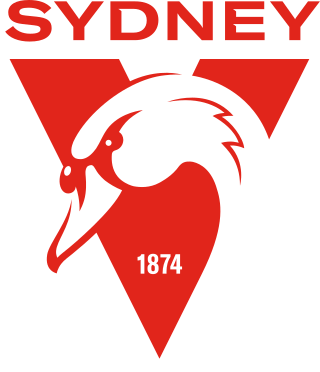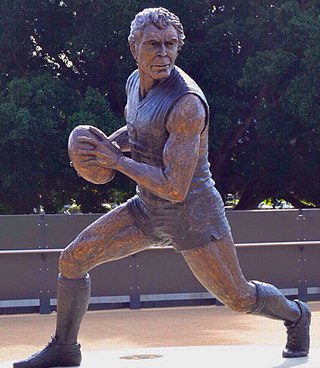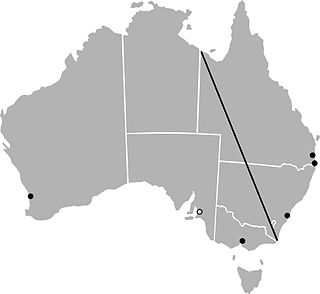National Competition proposals (since 1980)
The same twelve clubs competed in the VFL between 1925 and 1986, except in 1942 and 1943 when Geelong went into recess due to travel restrictions, petrol rationing and loss of players to service in World War II. At the end of 1981, the financially troubled South Melbourne relocated to Sydney, and there were a number of developments in the 1980s, with new clubs being proposed as the League became the pre-eminent competition in the country.
East Perth (1980)
In 1980 East Perth of the West Australian Football League applied to join the VFL as the League's first non-Victorian club. Nothing came of this application. [10]
Canberra / Australian Capital Territory (1981, 1986, 1988, 1990, 1993)
The Australian Capital Territory Australian Football League was the first league from a major city to express an interest in fielding a team in a national competition as early as the 1970s, however the first official bid was made in 1981, [11] [12] The VFL dismissed the bid, opting for a Sydney side instead. Following the entry of the Canberra Raiders, the sport in Canberra lost major ground to rugby league. In 1990, the ACTAFL began to arrange a deal with the AFL to field a Canberra-based team in the AFL Reserves competition from 1991, which the ACTAFL hoped would later lead to senior representation. [13] [14] The ACTAFL had received assurances from the AFL throughout 1990 that the bid was progressing well; but progress abruptly stalled and the bid failed in August 1990 when Port Adelaide made its bid to join the AFL, drawing almost all of the AFL's strategic focus to the South Australian situation. [14]
Norwood Redlegs (1982, 1985, 1986, 1990, 1994)

In 1982 the Norwood Football Club had sought discussions with the VFL about admissions but these met with cold responses. When Port Adelaide were privately seeking admission into the AFL during 1990, the AFL approached the club but Norwood decided to follow the SANFL's decision with its intentions undecided at the time. [15]
Fremantle Sharks (1987)
In 1987, the first year after the admission of the West Coast Eagles to the VFL, traditional rival WAFL clubs East Fremantle and South Fremantle had discussions on the possibility of merging and joining the VFL as a second Perth-based team. The merged club was to have been known as the Fremantle Sharks, and to have played at Fremantle Oval. [16]
Los Angeles Crocodiles (1987)
In 1987 a $10 million proposal from Perth magnate Errol Marron was put forward for a VFL expansion club based partly in Los Angeles and partly in Melbourne named the Los Angeles Crocodiles (attempting to cash in on the popularity of the previous year's hit film Crocodile Dundee ) with profits from increased television rights to fund a local league. Stadiums in the proposal included the Los Angeles Memorial Coliseum. In October 1987, Ross Oakley announced that the VFL had officially rejected the bid. [17] [18] [19] [20] [21] [22]
Port Adelaide (1990)
Seven years before their debut season in the AFL, SANFL club Port Adelaide applied to become the AFL's first South Australian club.
During the 1990 pre-season, Port Adelaide played a practice match against the Geelong Cats at Football Park before a crowd of 35,000. [23] However, the bid was met with legal issues within South Australia that resulted in the SANFL creating the Adelaide Crows. [24]
Norwood-Sturt (1990s)
A rival bid proposed by Norwood and financially struggling Sturt to combat Port Adelaide's second bid was seriously considered during the early 1990s. When Port Adelaide won the second licence the Norwood-Sturt merger was still discussed but relations between the clubs quickly soured. [25]
Tasmania (1992, 1994, 1995, 1997, 1998, 2008, 2019, 2021)
Tasmania is traditionally a strong Australian rules football state, and as such had long been touted as being a location for an AFL club prior to the state, being granted a license in 2023.
In October 1992, the AFL Commission voted on shutting down the Sydney Swans, as the club had accrued over AUD $9 million of debt. [26] With Melbourne clubs siding against the Swans, the AFL was desperate to offset the potential loss of the Swans to the national competition, so the AFL offered the TFL an AFL license. [26] However, the TFL declined the license fee, reported to be around AUD $4 million, claiming it was "10 years away" from being ready. [26] In addition to finding money to pay the license fee, the TFL would have faced significant travel costs to send a team to the mainland every second week. As a result of Tasmania declining a license, the AFL had to prepare a multi-million-dollar assistance package to keep the Sydney club viable.
In April 1994, Tasmanian Sports Minister, Peter Hodgman, spoke to the AFL about the possible introduction of a local team to the league and had raised the possibility of state funding. [27] Between 1994 and 1997, the bid was prepared for a Tasmanian team that involved the construction of a 30,000-capacity stadium at the Hobart Showgrounds in Glenorchy, at the cost of approximately $30 million. [28] This and every subsequent bid had been declined by the AFL until its successful 8th attempt in 2021.
The AFL's continued rejection of the Tasmanian AFL team raised significant controversy, with the Government of Australia launching a Senate inquiry in 2008 which AFL Commission CEO Andrew Demetriou and chairman Mike Fitzpatrick both declined to attend. [29] [30] [31]
Norwood Crows (1995)
During 1995 the Norwood Football Club, with the assistance of Wolf Blass, attempted to buy the Adelaide Crows and have them relocated to the Parade. [32]
Southport Sharks (1996)
By 1995 the Southport Sharks had reached 20,000 members began to lead the charge for a second Queensland team entering the Australian Football League. In 1996, the Sharks made their first bid to the AFL for inclusion in the national league, which was rejected by the AFL in favour of Port Adelaide's proposal. After which, the club continued to lobby for a licence.
Further attempts were made by the club to enter the AFL including purposed mergers with North Melbourne. [33]
Melbourne Hawks (1996)
The Melbourne Hawks would have comprised a merger between the Melbourne and Hawthorn Football Clubs at the end of the 1996 season. Out of all the proposed merger combinations in the 1990s, it was seemed as ideal as it was known that Hawthorn had a football team which ranked as one of the best of all time but were in a dire financial situation, as opposed to Melbourne which had a sound financial base but were a club which had mostly struggled on-field since their last premiership in 1964.
Despite the controversial approval of the Melbourne Football Club board and members, the merger was voted out by Hawthorn members after a passionate campaign led by Don Scott.
Sydney Celtic (2008)
In March 2008, it was revealed by the media that the AFL had considered a radical proposal to launch an Irish-dominated team in Sydney's western suburbs, which would perform before an international audience under the "Celtic" brand name. At the time, the Irish Experiment was peaking with numerous Irish players in the AFL. The "Sydney Celtics" plan was first put to AFL chief executive Andrew Demetriou in early 2007 by Gaelic Players Association executive Donal O'Neill. It was said that the proposal originated at the International Rules series in Ireland in late 2006 when O'Neill put forward a plan to purchase an AFL licence in Sydney. The idea had been boosted by the hype generated by Tadgh Kennelly's appearance for Sydney in the AFL Grand Final, having become one of the club's better locally known players. [34] However, the idea never materialised and the AFL has since stated that this was never a serious option [35] [36] and it proceeded to make plans for a new license, which was to become the Greater Western Sydney Giants.
Northern Territory (2018)
In October 2018, the Government of the Northern Territory announced that it would allocate $100,000 towards a "scoping study" to investigating whether the Territory should bid for an AFL licence when it becomes available. Chief Minister Michael Gunner and AFL Northern Territory CEO Stuart Totham met with AFL CEO Gillon McLachlan in Melbourne to discuss the potential bid. It was reported that an AFL licence would not become available until 2028 at the earliest.
If successful, the team would play its home games at TIO Stadium in Darwin and at Traeger Park in Alice Springs. [37] [38]










